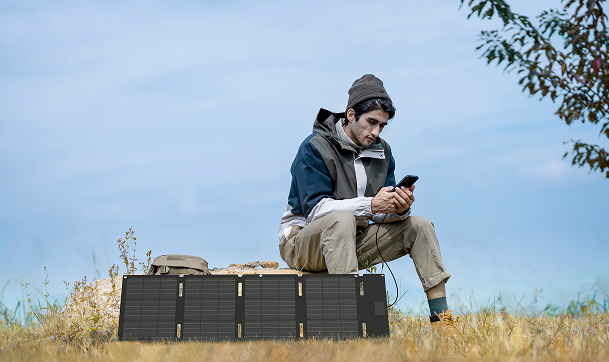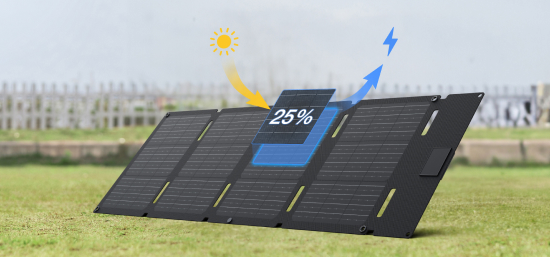Your Ultimate Guide to Choosing Solar Panels for Your Off-Grid Home
- Step One: Calculate Your Energy Needs
- Choosing the Right Type of Solar Panel
- Core Factors That Affect Real-World Performance
- EcoFlow Solar Panels for Your Home: Reliable and Adaptable
- How to Size Your Solar System
- Don’t Forget the Rest of the System
- Installation Tips for Off-Grid Success
- Final Thoughts
- FAQs about Solar Panels
Off-grid living demands a reliable source of power, and for most people, that means investing in solar panels for your home. But not every panel performs equally in remote conditions. With the right knowledge, you can select a system that delivers dependable energy year-round — whether you're powering a cabin, tiny house, or full-time off-grid property.
This guide explains what matters when choosing solar panels, how to match them to your lifestyle, and why EcoFlow solutions work well for off-grid needs.
Step One: Calculate Your Energy Needs
Before shopping for solar panels, measure your daily electricity consumption. For off-grid systems, every watt counts.
List your appliances, note their wattages, and multiply by daily usage hours:
Refrigerator: 150W × 10h = 1,500Wh
Lighting: 10 bulbs × 8W × 5h = 400Wh
Laptop: 60W × 4h = 240Wh
Total: ~2,140Wh (2.14kWh/day)
Most off-grid homes consume between 3–6kWh daily. Add a 20–30% buffer to account for inefficiencies, cloudy days, and future expansion.
Choosing the Right Type of Solar Panel
There are three types commonly used in residential settings. The best choice depends on space, climate, and performance expectations.
Monocrystalline Panels
- Efficiency: 18–23%
- Best for: Limited roof space or small off-grid setups
- Performance: Strong output even in partial shade or high temperatures
These are built from single-crystal silicon, allowing for higher efficiency in a smaller footprint. If you have limited mounting area or need top-tier performance, monocrystalline is the preferred option.
Polycrystalline Panels
- Efficiency: 15–17%
- Best for: Larger rooftops or open land where space isn’t a constraint
- Performance: Decent but less efficient in heat and low light
These use melted silicon fragments and cost less, but need more surface area for the same output.
Thin-Film Panels
- Efficiency: 10–13%
- Best for: Portable or lightweight needs (e.g., RVs, curved surfaces)
- Performance: Lower lifespan and power density
While thin-film may suit temporary or mobile installations, they’re rarely ideal for permanent off-grid homes.
Core Factors That Affect Real-World Performance
Durability
Choose panels with reinforced frames, tempered glass, and waterproofing (look for IP68 ratings). For areas with heavy snow or wind, ensure the panels meet IEC 61215 and IEC 61730 standards.
Temperature Coefficient
All panels lose efficiency as they heat up. A lower temperature coefficient (e.g., -0.35%/°C) means better performance in hot climates.
Warranty
Look for a 25-year performance warranty and at least a 10-year product warranty. This ensures long-term output and durability.
Portability (When Needed)
For modular off-grid setups, folding solar panels can be useful. Look for kickstands, carry cases, and quick connectors compatible with battery units.
EcoFlow Solar Panels for Your Home: Reliable and Adaptable
EcoFlow offers rigid and portable panels designed to meet the needs of off-grid homes, RV setups, and hybrid configurations.
EcoFlow Rigid Solar Panels (100W / 400W)
- Monocrystalline cells with 23% efficiency
- Built to mount on rooftops or ground frames
- IP68 waterproof and dustproof
- Seamless integration with EcoFlow Power Kits or DELTA Pro
These are ideal for users looking for a permanent solar array connected to large storage batteries.
EcoFlow Foldable Solar Panels (110W / 160W / 220W Bifacial / 400W)
- Lightweight, foldable, and weatherproof
- Built-in kickstands and carry cases
- Bifacial model collects sunlight from both sides, boosting efficiency by up to 25%
- Direct compatibility with EcoFlow portable power stations
These panels serve well in flexible setups — especially when space or mobility is a concern.
How to Size Your Solar System
Let’s say your home uses 5kWh daily, and your location averages 5 sun hours per day.
- Required solar output: 5,000Wh ÷ 5h = 1,000W
- With 400W panels: 3 panels would meet your needs
However, it's common to oversize systems by 20–30% to account for cloudy days, panel aging, and charging losses — so a 1,200–1,300W array offers a safer margin.
Don’t Forget the Rest of the System
Solar panels for your home need supporting components:
- Charge controller: Prevents battery overcharging. MPPT types offer higher efficiency.
- Battery storage: Stores power for use at night or during outages.
- Inverter: Converts DC solar output to standard AC electricity.
EcoFlow’s DELTA Pro system includes all of these in one modular design. With 3.6kWh of built-in capacity, expandable to 25kWh, it suits small cabins up to larger off-grid homes. The Power Hub consolidates wiring and monitoring, keeping installation straightforward.


Installation Tips for Off-Grid Success
Mounting and Orientation
- Tilt panels based on your latitude (e.g., 30–45° for most North American homes).
- Aim south in the northern hemisphere; aim north in the southern.
- Use ground mounts if the roof lacks space or structural strength.
Avoiding Shading
Even a small shaded area can cut output drastically. Trim surrounding trees and avoid placing panels near chimneys or vents. Consider microinverters if partial shading is unavoidable.
Weather Considerations
- Snow zones: Choose panels with strong load ratings and tilt them to encourage shedding.
- Tropical zones: Select corrosion-resistant frames and UV-treated surfaces.
Final Thoughts
Choosing the right solar panels for your home off the grid requires careful matching between your energy needs, space availability, and climate. Efficiency, longevity, and integration matter more than brand names or the lowest price tag.
EcoFlow’s solar panels — whether fixed or portable — offer high-efficiency monocrystalline construction, smart compatibility with EcoFlow power stations, and rugged weather resistance. Paired with a DELTA Pro or Power Kit system, they deliver an off-grid solution that scales with your lifestyle.
With the right setup, you can turn remote living into reliable living — powered by the sun.


FAQs about Solar Panels
Q1:Can I install solar panels for my home without professional help?
Yes, some solar panel systems — especially portable or plug-and-play models like EcoFlow’s Power Kits — are designed for self-installation. However, if your system involves roof mounting, electrical panel integration, or custom wiring, a licensed installer is recommended for safety and code compliance.
Q2:What happens during long periods of cloudy weather?
Even on cloudy days, solar panels produce electricity, though at reduced output. To stay off-grid during extended overcast periods, pair your panels with adequate battery storage and consider adding a backup generator or dual-fuel power station like the EcoFlow Smart Generator (Dual Fuel).
Q3:Are solar panels safe to use in snowy or freezing climates?
Yes. Quality panels with high snow load ratings can handle heavy winters. Look for ones tested to at least 5400 Pa. In cold regions, panels may even perform more efficiently due to lower operating temperatures. Just make sure to tilt them enough to shed snow naturally.
Q4:How do I clean and maintain solar panels?
Most solar panels need only occasional cleaning — once or twice a year — to remove dust, pollen, or bird droppings. Use a soft brush and clean water (no detergents). Avoid cleaning during the hottest part of the day to prevent thermal stress on the glass surface.
Q5:What should I do if I expand my off-grid home later?
Choose a scalable system from the start. EcoFlow systems, for example, allow you to add more panels, batteries, or even entire power modules without replacing your existing setup. Modular designs reduce cost and downtime when your energy demands grow.